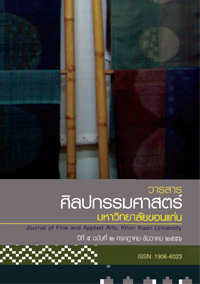ลวดลายผ้าทอร่วมสมัย ภายใต้ “จินตนาการใหม่”
Main Article Content
Abstract
จินตนการใหม่ไหมมัดหมี่อีสาน เป็นการวิจัยศิลปะประยุกต์ โดยใช้ ระเบียบวิธีวิจัยเชิงปฏิบัติการแบบมีส่วนร่วม ทางด้านศิลปกรรม มีวัตถุประสงค์ เพื่อมุ่งแสวงหาแนวคิด การออกแบบและการผลิตผ้าไหมต้นแบบโดยใช้เทคนิคการ สร้างลวดลายด้วยการมัดหมี่เพื่อให้เกิดลวดลายใหม่ ๆ ในการผลิตผ้าทอพื้นเมือง กระบวนการผลิตในงานวิจัยกำหนดให้ผลิตโดยใช้เครื่องมือเครื่องใช้ที่เป็นเทคโนโลยี พื้นบ้าน โดยมีผู้ร่วมวิจัยเป็นช่างทอพื้นบ้านในเขตจังหวัดขอนแก่นจำนวน 4 คน
จากการวิจัยพบว่าแนวคิดที่ผู้ร่วมวิจัยสามารถนำมาใช้ในการออกแบบ ลวดลายใหม่เกิดจากแนวคิดดังนี้
1) การจัดองค์ประกอบใหม่ในลวดลายโบราณ เป็นการนำเอาลวดลายผ้า โบราณของอีสานโดยเฉพาะลาย ผาสาด ลายเอี้ย ลายนาค มาจัดองค์ประกอบใหม่ ลดจำนวนของลวดลายบนผืนผ้าให้มีความเหมาะสม
2) การพัฒนารูปทรงของศิลปะพื้นบ้านมาเป็นแรงบันดาลใจ เป็นการนำ เอารูปร่างของเงาหนังตะลุงภาคอีสานมาเป็นแรงบันดาลใจในการออกแบบลายผ้า ทอร่วมสมัย โดยการตัดทอนรูปทรงให้สามารถสร้างลวดลายด้วยเทคนิคการมัดหมี่
3) การนำเอาคติความเชื่อมาเป็นแนวคิดในการออกแบบ เป็นการนำ เอาปรากฏการณ์ กบกินเดือน (จันทรุปราคา) มาเป็นแรงบันดาลใจ โดยมีการสร้าง ลวดลายกบโดยนำรูปร่างกบจริง รูปร่างกบจากศิลปะพื้นบ้าน มาพัฒนา ทั้งการ พัฒนารูปร่าง การคงรูปร่าง และตัดทอนรูปร่าง แล้วนำรูปร่างเหล่านั้นมาจัด องค์ประกอบใหม่
จากการผลิตผ้าต้นแบบของช่างทอพบว่า ในการมัดหมี่และการทอจำเป็น จะต้องมีการปรับปรุง เปลี่ยนแปลง ให้สอดคล้องกับเทคโนโลยี ดังนั้นช่างทอและ นักออกแบบควรทำงานร่วมกันจึงจะทำให้การทำงานราบรื่น โดยทั้งสามแนวคิดนี้ สามารถพัฒนาเป็นผ้าทอต้นแบบได้ในการประเมินจากผู้เชี่ยวชาญด้านการออกแบบ ลายผ้า กำหนดระดับค่าของคะแนนที่ 1-5 และผู้วิจัยกำหนดเกณฑ์ผ่านการประเมิน ที่ระดับ 4 ขึ้นไป ผลจากการประเมินผ้าต้นแบบของผู้เชี่ยวชาญด้านการออกแบบ ผ้า ที่ออกแบบครั้งนี้ผ่านการประเมินโดยรวมในระดับคะแนนเฉลี่ย(X) 4.1358 โดยมี ค่าเบี่ยงแบนมาตรฐานที่ 0.3665
Weaving Patterns through New Innovations
The term “new innovations in Isan Mat Mii Silk” refers to an applied arts project incorporating participatory action research. The research focused on investigating ways of fi nding ideas, designs, and models of silk weaving using the techniques of mat mii models to create new patterns. The new designs were used to produce local weavings through local technology tools. Participants in this research were four local weavers from Khon Kaen province who played a signifi cant role in creating the new patterns.
The study found that the ideas which the co-researchers used to generate new designs came from cloth patterns based on the concepts described below. New compositions based on ancient Isan patterns, specifi cally phaa saad, laai iya, and laai naak. The number of new patterns is reduced to a feasible quantity.
Developing patterns inspired by local arts. An example is incorporating shadows from Isan shadow puppet fi gures (nang pramothai) be the inspiration for designing a contemporary weaving pattern. In this method the shadow fi gures are simplifi ed in order to design cloth patterns using mat mii techniques.
Using local beliefs, teachings, and metaphors to inspire the development of new ideas or visions to produce new mai mii designs. For example, traditional beliefs about the lunar eclipse, which is called kob kin duen in Isan language (literally, “the frog eating the moon”), was used as the inspiration for a new weaving pattern. The designs were based on the shape of the frog from both nature and from local art works. The designs were also developed in terms of forms, stability, the size of the fi gures, and abstracting the shape to create a new composition.
New ways of weaving should be developed by making use of technology. Therefore, weavers and cloth designers had to work together in using the three concepts to achieve success. Expert cloth designers evaluated the quality of weaving using a scale of 1-5. The average score of the 54 pieces of cloth from this project was (X) 4.1358 with the standard deviation (SD) at 0.3665.Article Details
Content and information in articles published in the Journal of Fine and Applied Arts of Khon Kaen University is regarded as the opinion and sole responsibility of the author(s) directly; therefore, editors are not obliged to agree to or share any responsibility with regard to the content and information that appears within these articles.
All articles, information, content, image, etc. that have been published in the Journal of Fine and Applied Arts of Khon Kaen University is the copyright of the Journal of Fine and Appllied Arts of Khon Kaen University. Any person or organization who wishes to distribute all or parts of the articles for further dissemination or other usage must first receive permission from the Journal of Fine and Applied Arts of Khon Kaen University before proceeding to do so.


